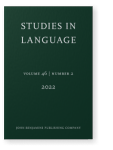Vol. 46:2 (2022) ► pp.285–322
The missing link between truth and intensification
Truth markers commonly evolve into intensifiers (Heine & Kuteva 2002), but we here argue that this shift is only indirect, and a counter-loosening phase necessarily mediates between truth marking and intensification. Counter-looseners instruct the addressee to avoid (or rather, constrain) the very natural interpretative process of broadening, whereby the speaker-intended concept would have been taken as a loosened, “more or less” interpretation of the meaning of the modified expression (Carston 2002). We provide a diachronic analysis for Hebrew mamash ‘really’, which supports our point, and we reinterpret diachronic analyses of other truth markers in order to show that they too underwent a counter-loosening phase before turning intensifiers. Finally, we briefly distinguish between a counter-loosening mediated intensifier evolution (for truth markers, particularizers and maximizers) and a direct evolutionary path into intensification for originally upscaling expressions (extreme scalar modifiers and augmenters).
Article outline
- 1.Introduction
- 2.‘Truth’ will ‘narrow’ before it ‘intensifies’
- 2.1Problematizing the truth marker to intensifier evolution
- 2.2Motivating explicit counter-loosening
- 2.3Counter-loosening and scalarity
- 2.4From ‘truth’ to ‘counter-loosening’ to ‘intensifying’
- 3.The evolution of Hebrew mamash ‘real(ly)’
- 3.1Phase I: Mamash turns into a truth marker
- 3.2Phase II: From truth marking to ‘counter-loosening’
- 3.3Towards Phase III: Between ‘counter-loosening’ and intensification
- 4.Finding the missing link for other truth-based intensifiers
- 4.1A necessary counter-loosening phase for truth markers
- 4.2A general mechanism of counter-loosening to intensification
- 4.3Direct versus indirect paths to intensification
- 5.Conclusions
- Acknowledgements
- Notes
-
References
